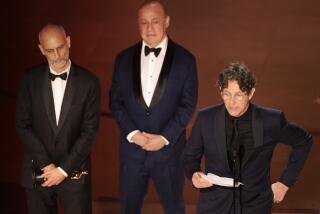For Oscar-seeking filmmakers, World War II never ends
Moviemakers love war. Make a war picture, you get explosions, high drama, death, sacrifice, heroism, villainy. Studios love war too because war is great for box office: More than half of the 10 best-grossing films of all time are filled with humans, Transformers, Na’vi, Orcs or wizards beating the stuffing out of one another.
But for sheer drama and emotional resonance, nothing compares to World War II. At least eight best picture Oscars have used that conflict directly or indirectly as a backdrop, including 1943’s “Casablanca,” 1970’s “Patton” and 1993’s “Schindler’s List,” and it’s easy to understand why these battlefields remain so fertile in award season. Fertile enough to include three such films in this season’s Oscar race: the tank crew drama “Fury,” which opened in October; the German code-breaking thriller “The Imitation Game,” opening over the Thanksgiving holiday; and the prisoner-of-war biopic “Unbroken,” heading for theaters on Christmas Day.
“World War II was the last ‘pure’ war,” says “Imitation Game” director Morten Tyldum. “It was purely heroic. There was someone who tried to conquer the world, who tried to exterminate people. If you want the human psyche, how we deal with humans in these situations, WWII is a very tangled place to go.”
This year’s films venture into WWII in varying ways — some with boots on the ground (“Fury”), some with brains in the shed (“Imitation”) and some from inside prison camps (“Unbroken”). In discussing them, the filmmakers reveal a few spoilers below.
“Imitation,” about the socially inept, closeted loner Alan Turing and his gang of cryptanalysts hired to break Germany’s Enigma code, “is about outsiders,” Tyldum says. “That makes it a different kind of war story. Alan’s fight was a different kind of battle, an external and internal fight. He could not return a hero, which is how a lot of soldiers feel about fighting today.”
One appeal for WWII is that it is familiar to nearly all audiences. Studied, taught and dramatized over and again, the war’s intricacies are familiar to most. That gives audiences a default story framework few other real-life events can approach, and it makes it possible for storytellers and filmmakers to jump right into the meat of things.
That’s exactly what it does in “Fury,” about the last stand a U.S. tank squad endures in the waning days of the war in Germany. And by doing that, it gives “Fury” room to tell a different story — one in which its lead character, like Turing, does not return home in victory.
“It’s a hero’s journey, but he’s never coming back,” says producer Bill Block. “That makes it heartbreakingly heroic.”
That twist resonates with modern audiences. The idea of a grand, teamwork-fueled war is hard to fathom these days; today, instead of wars we tend to have conflicts, or operations, or covert operations that leave history’s waters muddied and difficult to compartmentalize into good and evil.
“World War II still represents the American spirit in a way that one can only look back with admiration on,” says “Unbroken” producer Matthew Baer, whose film is a biopic of the unique life of Louis Zamperini, an Olympian who was shot down over the Pacific Ocean during the war, then interned by the Japanese. “The notion of what war looks like to an 18-, 19-, 20-year-old man right now if you’re going to Iraq or Afghanistan — that’s a different kind of fighting. Lou’s experience seemed a lot more black and white than modern-day conflicts appear to be.”
Yet with so many films about the same war, there is the technical quandary of how to make them distinct from one another. While “The Imitation Game” uses created battle footage that resembles a newsreel and “Unbroken” journeys into the tropical Pacific theater, “Fury” goes for mud and blood, tracer bullets and the claustrophobia not just of a tank but of a violence-filled story that largely takes place over one day.
“World War II has been covered cinematically so many times, it’s crucial that the director comes up with their own angle on what the conflict looks like,” says Baer. “For [“Fury” director and writer] David Ayer, that’s putting you right in battle so you can feel what it’s like to have a thousand bullets flying over your head. For us, we have aerial battles, water, islands — up in the air there’s no tranquillity to be found.”
Still, it’s been nearly 70 years since WWII ended, and it’s hard not to wonder whether as the Greatest Generation begins to pass into history if movies about that era will also pass into the mists of time. Tyldum doesn’t think so.
“It will always have this hold,” he says. “It was a world war. It was good versus evil. The world would have been a different place if the other side had won. That’s why it’s always going to be fascinating. Gruesome and horrible — but on an epic scale, with clarity.”
More to Read
From the Oscars to the Emmys.
Get the Envelope newsletter for exclusive awards season coverage, behind-the-scenes stories from the Envelope podcast and columnist Glenn Whipp’s must-read analysis.
You may occasionally receive promotional content from the Los Angeles Times.






